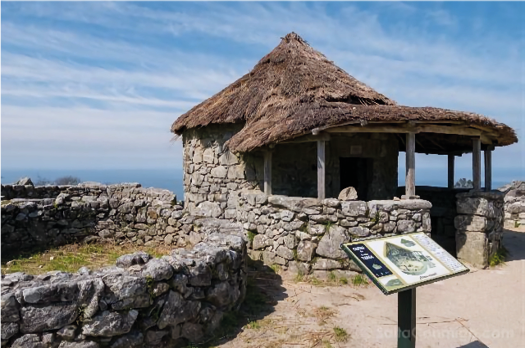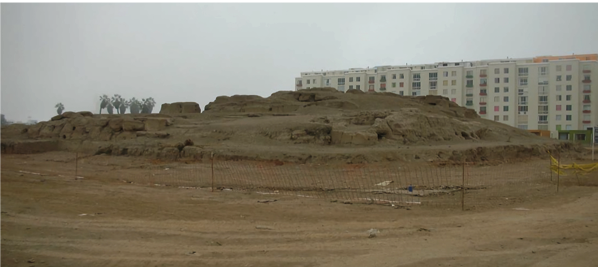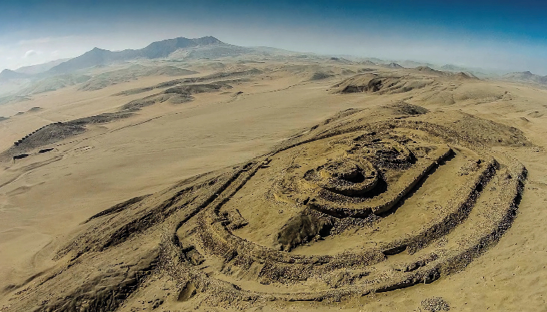ISSN 2410-5708 / e-ISSN 2313-7215
Year 12 | No. 33 | February - May 2023
© Copyright (2023). National Autonomous University of Nicaragua, Managua.
This document is under a Creative Commons
Attribution-NonCommercial-NoDerivs 4.0 International licence.
Approximation of the State of the Art on: Importance of the heritage value of archaeological sites
https://doi.org/10.5377/rtu.v12i33.15892
Submitted on June 28th, 2022 / Accepted on November 11th, 2023
Laura María Cordero Ortega
National Autonomous University of Nicaragua, Managua,
Nicaragua.
Ana del Carmen Zúniga Navarro
National Autonomous University of Nicaragua, Managua,
Nicaragua.
Section: Humanities and Art
Scientific research article
Keywords: Culture, Heritage conservation, Archaeological heritage, Valorization.
Abstract
The analysis of the state-of-the-art that was made is about the importance and recognition of the patrimonial value of archaeological sites.
The purpose of the study is to generate research based on the identified cognitive gaps and to present a proposal for a thesis topic on the enhancement of the archaeological site of the lost city in Las Brisas Nueva Segovia.
As a result of the bibliographic review, it is possible to appreciate the historical importance of the archaeological heritage to cement a cultural identity as a nation and also the problems generated by the waste of the development potential of the site in question.
1. Introduction
The approach of the presented state-of-the-art is about the importance of the patrimonial value of archaeological sites.
The patrimonial value corresponds as such to a registered value, having as important to contribute historical data of the society, being the faithful reflection of the events of a certain place.
In this case, the present study is focused on the archaeological area, having as its purpose to emphasize the importance of why to study and preserve the set of goods inherited from the past, through strategies, to emphasize the wealth provided by the sites in question and the use of this. Also, studying its surroundings, and identifying the environmental risks for the conservation of the site. Taking as a line of research: Heritage. 492 cultural heritage_ area 6- Population, education, social and intercultural inclusion.
2. Development
2.1. Development of the theoretical framework
Archaeology
It is called the science that reconstructs and explains the process of socio-cultural development of past society through the study as a whole of material cultural remains: sherds, spearheads, arrowheads, burials, bones, food remains, metates (grinding stones), among the most common and its scientific interpretation, in the absence of written documents that allow us to know directly our untold history. (Fernández, 2015).
That is to say that archaeology is the discipline that interprets a past society, using its dispersed and preserved vestiges through time.
Archaeological Heritage
Archaeological Heritage is not only formed by archaeological sites. Therefore, we can consider archaeological heritage as movable and immovable depending on its nature. Any object discovered in an archaeological site (ceramic pieces, coins, tools, etc.) can be considered a movable heritage, some of which end up in the showcases of our museums. On the other hand, the site itself is an immovable heritage as we cannot move it to any other place. (Carreton, 2018).
This conveys to us that archaeological heritage is everything suitable to be studied with archaeological methodologies.
Valorization
“They are the interventions on heritage assets declared National Monuments or in the process of being so, which make it possible for them to generate sustained flows of cultural, social and economic benefits for the community” (Department of Regional Investment Management, 2011).
In the article, it can be determined that the enhancement is a system that addresses the recovery and expansion of historic and heritage assets.
Heritage Conservation
Heritage conservation is an advanced discipline, still in need of techniques and concepts, and as such requires for its study and treatment comprehensive and multidisciplinary approaches, as it goes beyond the scale of the natural, built or museum, to assume a broader scope that involves society as a whole. (Lapidus, 1992).
This indicates that this practice is guided to ensure the material stability of cultural property, aided by measures that ensure its duration.
2.2. Background.
•(Tuckler, 2017). The conservation of the archaeological heritage of Nicaragua with the use of ICT. A proposal from the ¨Virtual Archaeology¨. Thesis for the degree of history majoring in archeology. Universidad Nacional Autónoma de Nicaragua, UNAN-Managua, Nicaragua.
The general purpose of this study is to evaluate the use of Information and Communication Technologies (ICT) for the conservation and dissemination of national archaeological heritage from the approach of virtual archaeology. The virtualization of archaeological heritage could guarantee the digital conservation of material remains and archaeological contexts in the face of their deterioration or destruction by natural and anthropic agents. Given the evident problem of constant threats of destruction to the archaeological heritage, the conventional methods of archaeological research (prospecting and excavation) must be accompanied by specialized techniques to obtain the archaeological record; in the case of excavations, the application and development of different tools that allow systematized documentation of the behavior of this record is of great importance. The virtual documentation of archaeological contexts was carried out through the use of short-range photogrammetry, concluding that this will serve as a means for the digital preservation of the archaeological context that will allow researchers to have a basis from which new interpretations can be inferred.

Figure 1: Hypothesis of the virtual reconstruction of a Bronze Age building from Cerro Bilanero, Ciudad Real-Spain. Source: www.parpatrimonio.com

Figure 2: Photogrammetric model of a sounding in which steps were discovered. Zacatecas, Mexico Source: www.parpatrimonio.com
• (Sánchez & Ledesma, 2017). Ecosystem diversity and archaeological heritage. Main environmental risks associated with sites in Guanahacabibes National Park. ECOVIDA Magazine, Cuba.
The following article reflects the problem encompassing environmental risks in archaeological heritage. The promoters of heritage preservation point out its importance in local identity and its testimonial value. Archaeological remains are evidence of the historical and cultural process of past societies based on their lifestyles, customs, idiosyncrasies, and religion. The problems that in recent years have had an anthropogenic impact, far from diminishing, tend to worsen in the face of a weak legislative framework for the preservation of archaeological heritage.
The article specifies the results and organizes them into three parts. In the first, the main components of archaeological heritage are introduced; in the second, the areas and types of existing natural and anthropic risks are identified; the natural effects and the effects of human actions are identified. Finally, in the third part, an integrated proposal of environmental valorization and mitigation for the archaeological heritage under study is presented.

Figure 3: Distribution of archaeological sites reported in the Guanahacabibes Peninsula Biosphere Reserve. Source: Management Plan 2012-2016 of the Guanahacabibes Peninsula Managed Resources Area.

Figure 4: Flooded gallery in Cueva las Perlas.
•(Cantuta, 2018). Interpretation center to recover and understand the cultural heritage value of the archaeological site Moqi, 2018. Thesis for the professional degree of Architect Volume I. Universidad Privada de Tacna, Peru.
The objective is based on designing an Interpretation Center to recover the Cultural Heritage Value of Moqi and understand its cultural, natural, and heritage characteristics; the importance is addressed before the loss of vestiges and archaeological information present in the area leaving evidence of the limited conservation intervention of the archaeological site; the research is descriptive level and the intervention is non-experimental implementing a probabilistic sampling. Given the magnitude of the floating visitor population, the research had a character of observation and documentary review, as well as, tourism statistics in the city of Tacna were analyzed.
(Cantuta, 2018) It highlights the care and special attention that should be taken in the intervention of places with cultural value since this requires a total understanding of their cultural and historical connotations, and always work in defense of their preservation and dissemination. The final part of the document addresses the recommendations and the benefits of good heritage management at the community level in cultural and economic aspects.

Figure 5: Entrance façade.

Figure 6: Facade of the administrative area and Moqi Alto viewpoint terrace.
•(García, 2021). The enhancement of the archaeological heritage of the Iron Age applied to the so-called “Cantabrian settlements”. Master’s Thesis, Master in Historical and Territorial Heritage. University of Cantabria, Spain.
The objective of the document is to carry out a critical review of the valorization projects developed in the last decades in the Cantabrian settlements of Cabezón de la Sal and Argüeso; the use of experimental architectural reconstructions as the main vehicle of diffusion in sites of this type is covered in the content; that is to say, to verify the strengths and weaknesses that they present within their scientific, didactic and touristic factor for the dissemination of pre-Roman Cantabria in the region.
In the conclusions it is mentioned throughout the four sections of the content that the main characteristics of the domestic architecture of the Second Iron Age in the north of the peninsula were exposed and was checked some of the main methods of enhancement and dissemination of archaeological heritage through reconstructions, replicas and recreations carried out in other parts of the peninsula.

Figure 7: Reconstruction of the Iberian citadel of Calafell (Tarragona).
Accessed: August 8, 2020. Available: https://arqueotrip.com/calafell-ciutadella-iberica/

Figure 8: Reconstruction of the Iberian citadel of Calafell (Tarragona). Accessed: August 5, 2020.
Available: https://saltaconmigo.com/blog/2019/04/monte-santa-tecla-trega-castro/
•(Santamaria, Bambarén, & Arias, 2021). Guidelines for the management of archaeological sites in metropolitan Lima. Research work presented for the Academic Degree of Magister in public management, Universidad del Pacifico, Lima, Peru.
The text addresses from a very specific perspective the loss and lack of recognition of the value of archaeological sites in metropolitan Lima, the objective of the research is to propose strategic guidelines to optimize the management of archaeological sites in Metropolitan Lima and achieve their value and sense of social appropriation by citizens; The methodology considered is based on non-experimental research with a qualitative approach that allows according to (Santamaria, Bambarén, & Arias, 2021) to analyze reality through the collection and systematization of experiences in an explanatory and critical way, considering the aforementioned approach it was necessary to use two research methods consisting of participatory observation and semi-structured interviews.
Among the conclusions, a special emphasis is made on the combination of leadership and shared responsibility on the part of the so-called strategic allies, for the continuous action of the enhancement of archaeological sites with a cultural, historical, and social weight. It is relevant among the recommendations the impulse to retake the strategic guidelines, considered starting points for the efficient and effective management of cultural heritage in any of its classifications, whether movable or immovable, or immaterial.

Figure 9: Huaca Huantinamarca (pre-Hispanic archaeological site located in the district of San Miguel, province of Lima, Peru) before the intervention. Source: (Santamaria, Bambarén, & Arias).
•(Reyna & Angeles, 2021). Local identity for sustainable tourism in the archaeological sites of Casma 2021. Thesis for the professional degree of Architect. Universidad César Vallejo, Chimbote, Peru.
The text is focused on the objective of developing sustainable tourism in the various archaeological sites that the district of Casma has; The research is of the basic type, with an ethnographic and action design, and it tells how to have a balance in the planning of tourism so that its impact does not cause damage to the archaeological monuments, safeguarding the territory and local identities. Monuments require useful spaces for research, preservation, and dissemination, which is why it is concluded that architectural infrastructure such as site museums, interpretation centers, and research laboratories are the pillar for preserving an archaeological monument.
Finally, the necessary actions for tourism development in the district of Casma are established, highlighting as a strategy that the social actors participate in the effort to strengthen the archeological sites, resulting in urban social strategies that are coherent with the needs of the population and the tourist.

Figure 10: Chankillo Monumental Archaeological Complex (Located in the Casma Valley, in the eponymous district and province, in the Ancash region of Peru).
2.3. Identified Cognitive Gaps
Main Cognitive Gaps
•Mitigation plan against environmental risk threats to archaeological heritage.
•Archaeological site analysis using tools adapted to site conditions as appropriate.
•Proposals linked to cultural heritage management in other districts, counties, or provinces.
•Valorization of archaeological sites through actions that meet the needs of the context and the environment.
2.4. Problem Statement
Archaeological ruins and sites are a material expression of the past, or rather, part of the social behaviors and actions of past communities. Archaeological remains, therefore, constitute a fragmented material past, which is commonly called archaeological heritage (Zapatero, 1998, p. 7).
Unfortunately, these archaeological sites are constantly exposed to dangers that threaten their survival over time; among the present risks to their conservation are environmental hazards, urban exploitation, agricultural development, and poor management of tourist exploitation. As can be seen in the site of interest located in the Finca “El Jícaral”, municipality of Santa María in the department of Nueva Segovia, identifying the affectation produced by the agricultural activity due to the lack of knowledge of the presence of the archaeological site.
The creation of cultural heritage is a vital phenomenon for all peoples and is produced from the selection of goods that will constitute this heritage. In this sense, the expression of culture refers to a philosophical concept, first and foremost: cultural identity considered as consciousness. Archaeology is a potential engine of cultural development necessary for the balance of a community’s development (Woynar, 2003, p. 41).
For this reason, it is essential to comply with the legal actions of governmental entities regarding the protection of archaeological heritage, as well as to create awareness among the population to ensure the application of practices for the protection and field studies.
3. Conclusion
The present state-of-the-art was based on the studies carried out with a focus on the valorization of the archaeological heritage in the nations; the importance of the preservation that these sites have for the society due to their significance, historical and touristic value, being these basic components of the identity of the peoples that constitute it, is highlighted.
Likewise, at the moment of establishing the conditions and problems, the environmental risks suffered by the archaeological sites were reflected, warning that archaeology has been related to environmental problems in diverse forms and eventualities, carefully tracing descriptions of the diverse ecosystems of Mesoamerica made by explorers and conquerors since colonial times.
For the aforementioned, the main cognitive gaps were obtained, to promote strategies that promote the conservation and dissemination of archaeological sites.
Incentives should be created in conjunction with the delegations involved in the subject, to avoid destructive actions, promoting the creation of museums and appropriate spaces for the presentation of archaeological assets, as well as cultural events involving heritage.
Cited Works
Betsabé, A. A., Alexander, C. C., & Adriana, R. P. (2019). Implementación de Buenas Prácticas en turismo para Museos y Sitios . Nicaragua.
Cantuta, A. C. (2018). Centro de interpretación para recuperar y comprender el valor patrimonial cultural del sitio arqueológico moqi, 2018. Peru.
Carreton, A. (2018). Patrimonio Inteligente. Obtenido de Patrimonio inteligente: https://patrimoniointeligente.com/patrimonio-arqueologico/
Castro, M. d. (2021). Propuesta arquitectónica de una infraestructura contiguo a las preexistencias arqueológicas con valor patrimonial en Licurnique del distrito de Olmos. Perú: Universidad Católica Santo Toribio de Mogrovejo.
Departamento Gestión de Inversiones Regionales. (2011). Programa Puesta en Valor del Patrimonio. Guia Operativa Puesta en Valor del Patrimonio, 27.
Fernández, J. Z. (2015). Cuaderno comunitario el patrimonio cultural arqueológico nicaragüense y su conservacion, 28.
Fiallos, F. R. (26 de Octubre de 2015). Propuesta de elaboración de medios de interpretación turística para el recorrido auto-guiado en el museo-sitio huellas de acahualinca, patrimonio cultural de Managua, Nicaragua. leon, Nicaragua.
García, D. C. (2021). La puesta en valor del patrimonio arqueológico de la Edad del Hierro aplicado a los denominados “Poblados Cántabros”. España.
Lápidus, L. (1992). Crear aptitudes y actitudes ante el patrimonio. Icomos, 351.
Reyna, L. C., & Angeles, G. N. (2021). Identidad local para el Turismo sostenible en los sitios arqueológicos de Casma 2021. Peru.
Sánchez, M. R., & Ledesma, Y. M. (2017). Diversidad de ecosistemas y patrimonio arqueológico. Principales riesgos ambientales asociados a sitios del Parque Nacional Guanahacabibes, Cuba. ECOVIDA, 14.
Santamaria, J. A., Bambarén, N. F., & Arias, M. S. (Marzo de 2021). Lineamiento para la gestión de los sitios arqueológicos de lima metropolitana. Lima, Perú: Universidad del Pacífico.
Tuckler, J. A. (AGOSTO de 2017). La conservación del patrimonio arqueológico de Nicaragua con el uso de las tic. Managua, Nicaragua.
Ulloa, F. C., & Cambronero, A. B. (2016). Gestión cultural y comunidad: el manejo de los sitios arqueológicos con esferas de piedra del diquís. En Memoria y congreso iberoamericano del patrimonio cultural Lo material y lo inmaterial (pág. 498). Costa Rica.